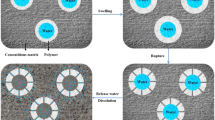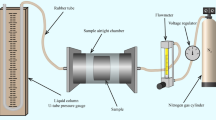Abstract
When concrete is placed in extreme climates, quality control of concrete is so difficult that cracking due to hydration heat easily occur. In the paper, new encapsulation technique is developed for control of cement hydration reaction through encapsulation of chemical admixtures. Lithium carbonate (Li2CO3) as accelerator and tartaric acid (C4H6O6) as retarder are respectively selected for core material. For wall material of microcapsule, acrylic resin, silicon monoxide, and starch is synthesized. Several tests including chemical shrinkage, setting time, compressive strength, and adiabatic temperature are performed for evaluating an effect of the invented microcapsule on cement hydration behavior. Through encapsulation of accelerator and retarder, cement hydration behaviors like setting time, strength, shrinkage, and hydration heat are reasonably controlled. The developed encapsulation technique can be applied for manufacturing high durable concrete in harsh environmental condition avoiding cracking.
Similar content being viewed by others
References
ASTM International (2007). Standard test method for chemical shrinkage of hydraulic cement paste, ASTM C1608-07, West Conshohocken, PA.
Benita, S. (1998). Microencapsulation: Methods and industrial application, Marcel Dekker, Inc.
Boh, B. and Sumiga, B. (2008). “Microencapsulation technology and its applications in building construction materials.” RMZ-Materi Geoenviron, Vol. 55, No. 3, pp. 329–44, (http://www.rmz-mg.com/letniki/rmz55/RMZ55_0329-0344.pdf).
Hunger, M., Entrop, A. G., Mandilaras, I., Brouwers, H. J. H., and Founti, M. (2009). “The behavior of self-compacting concrete containing micro-encapsulated phase change materials.” Cem. Conc. Compos., Vol. 31, No. 10, pp. 731–743, (http://www.sciencedirect.com/ science/article/pii/S0958946509001267).
Ishida, T., Chaube, R. P., Kishi, T., and Maekawa, K. (1999). “Microphysical approach to coupled autogenous and drying shrinkage of concrete.” Conc. Lib., JSCE. Vol. 33, No. 1, pp. 71–81.
ISO-International Organization for Standardization (2008). Determination of setting time and soundness, ISO 9597, Geneva.
ISO-International Organization for Standardization (2009). Determination of strength, ISO 679, Geneva.
KISTI-Korea Institute of Science and Technology Information (2003). Water soluble polymers (in Korean).
Kondo, T. (2001). “Microcapsules: Their science and technology, Part I, Various preparation methods.” J. Oleo Sci., Vol. 50, No. 1, pp. 1–11, (https://www.jstage.jst.go.jp/article/jos/50/1/50_1_1/_article)
Kwon, S.-J. and Na, U.-J. (2011). “Prediction of durability for RC columns with crack and joint under carbonation based on probabilistic approach.” Inter. J. Conc. Struct. Mater., Vol. 5, No. 1, pp. 11–18, (http://www.ceric.net/wonmun2/kci/KCI_3_2011_5_1_11(C).pdf).
Mehta, P. K. and Monteiro, K. J. M. (2006). Concrete: Microstructure, properties and materials, 3rd Edn, McGraw-Hill, New York.
Park, S.-K., Kim, J.-H., Nam, J.-W., Phan, H.D., and Kim, J.-K. (2009). “Development of anti-fungal mortar and concrete using Zeolite and Zeocarbon microcapsules.” Cem. Concr. Compos., Vol. 31, No. 7, pp. 447–453, (http://www.sciencedirect.com/science/article/pii/S0958946509000687).
Park, S. S., Kwon, S. J., and Jung, S. H. (2012). “Analysis technique for chloride penetration in cracked concrete using equivalent diffusion and permeation.” Constr. Build Mater., Vol. 29, No. 4, pp. 183–192, DOI: 10.1016/j.conbuildmat.2011.09.019.
Park, S. S., Kwon, S. J., Jung, S. H., and Lee, S. W. (2012). “Modeling of water permeability in early aged concrete with cracks based on micro pore structure.” Constr. Build Mater., Vol. 27, No. 1, pp. 597–604, DOI: 10.1016/j.conbuildmat.2011.07.002.
Rai, S., Singh, N. B., and Singh, N. P. (2006). “Interaction of tartaric acid during hydration of Portland cement.” Indian J. Chem. Technol., Vo1. 13, No. 3, pp. 255–261, (http://nopr.niscair.res.in/bitstream/123456789/7027/1/IJCT%2013(3)%20255-261.pdf/bitstream/123456789/7027/1/IJCT%2013(3)%20255-261.pdf).
Robbins, M. E. (2007). “Predicting temperature rise and thermal cracking in concrete.” PCA (Portland Cement Association), R&D Serial No. 3030, (http://stuff.mit.edu/afs/athena/dept/cron/project/concrete-sustainability-hub/Literature%20Review/Building%20Energy/Concerte%20Industry%20Reports/PCA%20CD%20Cement%20Research%20Library%202008/reports/SN3030.pdf/afs/athena/dept/cron/project/concrete-sustainability-hub/Literature%20Review/Building%20Energy/Concerte%20Industry%20Reports/PCA%20CD%20Cement%20Research%20Library%202008/reports/SN3030.pdf).
Sakai, E. (2006). Technology of chemical admixtures for concrete, CMC Publisher.
Song, H. W., Cho, H. J., Park, S. S., Byun, K. J., and Maekawa, K. (2001). “Early-age cracking resistance evaluation of concrete structure.” Conc. Sci. Eng., Vol. 3, No. 3, pp. 62–72, (http://concrete.t.u-tokyo.ac.jp/research/intro/material/add-final/CSAE01003.pdf).
Song, H. W., Kwon, S. J., Byun, K. J., and Park, C. K. (2006). “Predicting carbonation in early aged cracked concrete.” Cem. Concr. Res., Vol. 36, No. 5, pp. 979–989, DOI: 10.1016/j.cemconres.2005.12.019).
Song, Q. W., Yi, L., Jianwei, X., Hu, J. Y., and Yeun, M. (2007). “Thermal stability of composite phase change material microcapsules incorporated with silver nano-particles.” Polymer, Vol. 48, pp. 3317–3323, DOI: 10.1016/j.polymer.2007.03.045.
Takeuchi, T., Nishiyama, N., Mihashi, H., and Sakai, E. (2007). “The study on the hydration generation of heat control of the cement by the retarder inclusion microcapsule.” Japan Cement Association Proceedings of Cement and Concrete, Vol. 60, No. 3, pp. 568–574 (in Japanese).
Tittelboom, K., V., De Belie, N., Loo, D. V., and Jacobs, P. (2011). “Self-healing efficiency of cementitious materials containing tubular capsules filled with healing agent.” Cem. Concr. Compos., Vol. 33, No. 4, pp. 497–505, (http://www.sciencedirect.com/science/article/pii/S0958946511000102).
Tyagi, V. V., Kaushik, S. C., Tyagi, S. K., and Akiyama, T. (2011). “Development of phase change materials based microencapsulated technology for buildings: A review.” Renewable and Sustainable Energy Review, Vol. 15, No. 2, pp. 1373–1391, DOI: 10.1016/j.rser.2010.10.006.
Author information
Authors and Affiliations
Corresponding author
Rights and permissions
About this article
Cite this article
Choi, Y.C., Cho, Y.K., Shin, KJ. et al. Development and application of microcapsule for cement hydration control. KSCE J Civ Eng 20, 282–292 (2016). https://doi.org/10.1007/s12205-015-0281-8
Received:
Revised:
Accepted:
Published:
Issue Date:
DOI: https://doi.org/10.1007/s12205-015-0281-8




